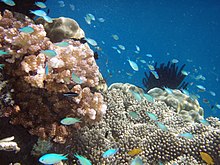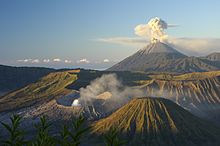Nature tourism
Main articles: Fauna of Indonesia and Flora of Indonesia
Indonesia has a well-preserved, natural ecosystem with rainforests that stretch over about 57% of Indonesia's land (225 million acres), approximately 2% of which are mangrove systems.[30][31] One reason why the natural ecosystem in Indonesia is still well-preserved is because only 6,000 islands out of 17,000 are permanently inhabited.[32] Forests on Sumatra and Java are examples of popular tourist destinations. Moreover, Indonesia has one of longest coastlines in the world, measuring 54,716 kilometres (33,999 mi),[33] with a number of beaches and island resorts, such as those in southern Bali, Lombok,[34] Bintan and Nias Island.[35] However, most of the well-preserved beaches are those in more isolated and less developed areas, such as Karimunjawa, the Togian Islands, and the Banda Islands.
Dive sites
With more than 17,508 islands, Indonesia presents ample diving opportunities. With 20% of the world's coral reefs, over 3,000 different species of fish and 600 coral species, deep water trenches, volcanic sea mounts, World War II wrecks, and an endless variety of macro life, scuba diving in Indonesia is both excellent and inexpensive.[36] Bunaken National Marine Park, at the northern tip of Sulawesi, claims to have seven times more genera of coral than Hawaii,[37] and has more than 70% of all the known fish species of the Indo-WesternPacific.[38] According to Conservation International, marine surveys suggest that the marine life diversity in the Raja Ampat area is the highest recorded on Earth.[39] Moreover, there are over 3,500 species living in Indonesian waters, including sharks, dolphins, manta rays,turtles, morays, cuttlefish, octopus and scorpionfish, compared to 1,500 on the Great Barrier Reef and 600 in the Red Sea.[40] TulambenBay in Bali boasts the wreck of the 120 metres (390 ft) U.S. Army commissioned transport vessel, the Liberty.[41] Other popular dive sites on Bali are at Candidasa and Menjangan. Across the Badung Strait from Bali, there are several popular dive sites on Nusa Lembonganand Nusa Penida. Lombok's three Gilis (Gili Air, Gili Meno and Gili Trawangan) are popular as is Bangka. Some of the most famous diving sites in Indonesia are also the most difficult to reach, with places like Biak off the coast of Papua and the Alor Archipelago among the popular, more remote, destinations for divers.
Surf breaks
Surfing is also a popular water activity in Indonesia and the sites are recognised as world class.[42] The well-known sports are mostly located on the southern, Indian Ocean side of Indonesia, for example, the large oceanic surf breaks on southern Java. However, the north coast does not receive the same surf from the Java Sea. Surf breaks can be found all the way along Sumatra, down to Nusa Tenggara, including Aceh, Bali, Banten, Java, Lombok, the Mentawai Islands, and Sumbawa. Although Indonesia has many world-class surfing spots, the majority of surfers are came from abroad, especially Australia and United States. However, the seed of local surfing enthusiast began develop in Bali and West Java's Pelabuhan Ratu and Pangandaran beach, mostly came from nearby cities of Jakarta and Bandung. On Bali, there are about 33 surf spots, from West Bali to East Bali including four on the offshore island of Nusa Lembongan. In Sumbawa, Hu'u and Lakey Beach in Cempi Bay are popular surfing spots among surfing enthusiast. Sumatra is the second island, with the most number of surf spots, with 18 altogether. The common time for surfing is around May to September with the trade winds blowing from east to south-east. From October to April, winds tend to come from the west to north-west, so the east coast breaks get the offshore winds.[citation needed]
Two well-known surf breaks in Indonesia are the G-Land in the Bay of Grajagan, East Java, and Lagundri Bay at the southern end of Nias island. G-Land was first identified in 1972, when a surfer saw the break from the window of a plane. Since 6 to 8-foot (Hawaiian scale) waves were discovered by surfers at Lagundri Bay in 1975, the island has become famous for surfing worldwide.[citation needed]
National parks
Main article: List of national parks of Indonesia
Bogor Botanical Gardens established in 1817, and Cibodas Botanical Gardens established in 1862, are two among the oldest botanical gardens in Asia. With rich collections of tropical plants, these gardens is the center of botanical research as well as tourism attraction since colonial era.
There are 50 national parks in Indonesia, of which six are World Heritage listed. The largest national parks in Sumatra are the 9,500-square-kilometre (3,700 sq mi) Gunung Leuser National Park, the 13,750-square-kilometre (5,310 sq mi) Kerinci Seblat National Park and the 3,568-square-kilometre (1,378 sq mi) Bukit Barisan Selatan National Park, all three recognised as Tropical Rainforest Heritage of Sumatra on the UNESCO World Heritage list. Other national parks on the list are Lorentz National Park in Papua, Komodo National Park in the Lesser Sunda Islands, and Ujung Kulon National Park in the west of Java.
To be noticed, different national parks offer different biodiversity, as the natural habitat in Indonesia is divided into two areas by theWallace line. The Wallacea biogeographical distinction means the western part of Indonesia (Sumatra, Java, Kalimantan) have the same flora and fauna characteristics as the Asian continent, whilst the remaining eastern part of Indonesia has similarity with the Australian continent.[34]
Many native species such as Sumatran elephants, Sumatran tigers, Sumatran rhinoceros, Javan rhinoceros and Orangutans are listed as endangered or critically endangered, and the remaining populations are found in national parks and other conservation areas. Sumatran orangutan can be visited in the Bukit Lawang conservation area, while theBornean orangutan can be visited in Tanjung Puting national park, Central Kalimantan. The world's largest flower, rafflesia arnoldi, and the tallest flower, titan arum, can be found in Sumatra.
The east side of the Wallacea line offers the most remarkable, rarest, and exotic animals on earth.[43] Birds of Paradise, locally known as cendrawasih, are plumed birds that can be found among other fauna in Papua New Guinea. The largest bird in Papua is the flightless cassowary. One species of lizard, the Komodo dragon can easily be found onKomodo, located in the Nusa Tenggara lesser islands region. Besides Komodo island, this endangered species can also be found on the islands of Rinca, Padar and Flores.[44]
Volcanoes
Hiking and camping in the mountains are popular adventure activities. Some mountains contain ridge rivers, offering rafting activity. Though volcanic mountains can be dangerous, they have become major tourist destinations. Several tourists have died on the slopes ofMount Rinjani, Indonesia's second highest volcano and a popular destination for climbers visiting Lombok in eastern Indonesia. Popular active volcanoes are the 2,329-metre (7,641 ft) high Mount Bromo in the East Java province with its scenic volcanic desert around the crater, the upturned boat shaped Tangkuban Perahu and the volcanic crater Kawah Putih, north and south of Bandung respectively and both with drive-in access up to the crater, the most active volcano in Java, Mount Merapi near Yogyakarta, and the legendary Krakatauwith its new caldera known as anak krakatau (the child of Krakatau). Gede Pangrango volcano in West Java is also a popular hiking destination, especially among domestic hikers.
In Sumbawa, Mount Tambora with its historical massive volcanic eruption back in 1815 that produced massive caldera also had gained attention among hikers. In neighboring island of Flores, the three-colored volcanic crater-lake of Kelimutu is also hailed as one of Indonesia's natural wonder and had attracted visitors worldwide. Puncak Jaya in the Lorentz National Park, the highest mountain in Indonesia and one of the few mountains withice caps at the (tropical) equator[45][46] offers the opportunity of rock climbing. In Sumatra, there are the remains of a supervolcano eruption that have created the landscape ofLake Toba close to Medan in North Sumatra.
source wikipedia






No comments:
Post a Comment